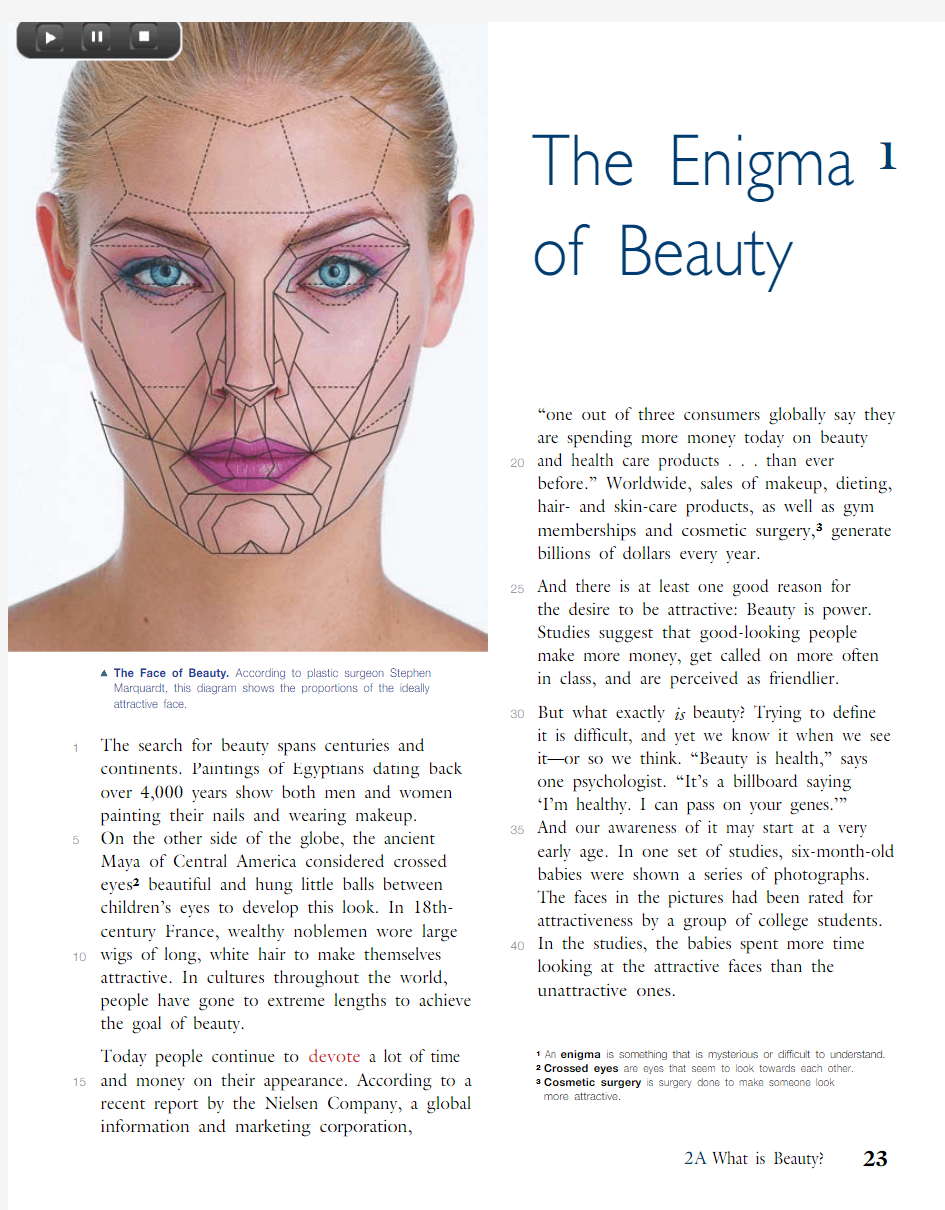L3-U02-LA-RC


The search for beauty spans centuries and
continents. Paintings of Egyptians dating back over 4,000 years show both men and women painting their nails and wearing makeup. On the other side of the globe, the ancient Maya of Central America considered crossed eyes 2 beautiful and hung little balls between children’s eyes to develop this look. In 18th-century France, wealthy noblemen wore large wigs of long, white hair to make themselves attractive. In cultures throughout the world, people have gone to extreme lengths to achieve the goal of beauty.
Today people continue to devote a lot of time and money on their appearance. According to a recent report by the Nielsen Company, a global information and marketing corporation,
“one out of three consumers globally say they are spending more money today on beauty and health care products . . . than ever
before.” Worldwide, sales of makeup, dieting, hair- and skin-care products, as well as gym memberships and cosmetic surgery,3 generate billions of dollars every year.
And there is at least one good reason for the desire to be attractive: Beauty is power. Studies suggest that good-looking people make more money, get called on more often in class, and are perceived as friendlier.But what exactly is beauty? Trying to define it is difficult, and yet we know it when we see it—or so we think. “Beauty is health,” says one psychologist. “It’s a billboard saying ‘I’m healthy. I can pass on your genes.’” And our awareness of it may start at a very early age. In one set of studies, six-month-old babies were shown a series of photographs. The faces in the pictures had been rated for attractiveness by a group of college students. In the studies, the babies spent more time looking at the attractive faces than the unattractive ones.
1 An enigma is something that is mysterious or difficult to understand.2
Crossed eyes are eyes that seem to look towards each other.3 C osmetic surgery is surgery done to make someone look more attractive.
1
5
10
15
20
25
30
35
40
The Face of Beauty. According to plastic surgeon Stephen Marquardt, this diagram shows the proportions of the ideally attractive face.
2A What is Beauty? 23
The Enigma 1
of Beauty
The idea that even babies judge appearance makes perfect sense to many researchers. In studies done by psychologists such as Victor Johnston at New Mexico State University and David Perrett at St. Andrews University in
Scotland, men regularly showed a preference for women with certain features: larger eyes, fuller lips, and a smaller nose and chin. Another study suggests that women prefer men with large shoulders and a narrow waist. According to scientists, the mind unconsciously tells men and women that these traits—the full lips, clear skin, strong shoulders—equal health and genetic well-being. In other words, it’s a fundamental part of human nature to look for these qualities in a mate .
Not everyone agrees with this notion , however. “Our hardwiredness can be altered by all sorts of expectations—predominantly cultural,” says C. Loring Brace, an anthropologist at the University of Michigan. What is considered attractive in one culture might not be in another. Look in most Western fashion magazines, for example, and the women on the pages are thin. But is this the “perfect” body type for women worldwide? Douglas Yu, a biologist from Great Britain, and Glenn Shepard, an anthropologist at the University of California at Berkeley, say no; what is considered beautiful is subjective and varies around the world. Yu and Shepard found in one study, for example, that native peoples in
southeast Peru preferred shapes regarded as overweight in Western cultures.
Take another example: in every culture, one’s hairstyle sends a clear message. In the Huli culture of Papua New Guinea (an island nation north of Australia), men grow their hair long as a symbol of health and strength. Teenage boys in this culture learn from a young age to style and decorate their hair—a behavior more commonly associated with the opposite gender in many cultures. It is also the men (not women) in this culture who are the objects of beauty. For certain festivals and celebrations, men dress up and paint their faces. The more colorful a man is, the more masculine 4 —and attractive—he is considered.
For better or worse, beauty plays a role in our lives. But it is extremely difficult to define exactly what makes one person attractive to another. Although there do seem to be certain physical traits that are considered universally appealing, it is also true that beauty does not always conform to a single, uniform standard. A person’s cultural background, for example, may influence what he or she finds attractive in others. In the end, beauty really is, as the saying goes, in the eye of the beholder.
24 Unit 2 Skin Deep
45
50
55
60
65
70
75
80
85
90
95
100
4
Masculine
qualities and things are typical for men, in contrast to women.
Men of the Huli people of Papua New Guinea prepare for a sing-sing (an annual festival). They dress in feathers and paint to resemble the local birds of paradise. “Here men are the objects of beauty,” says scientist Nancy Sullivan.
A New York model prepares for a beauty competition by having her hair cut and colored.
